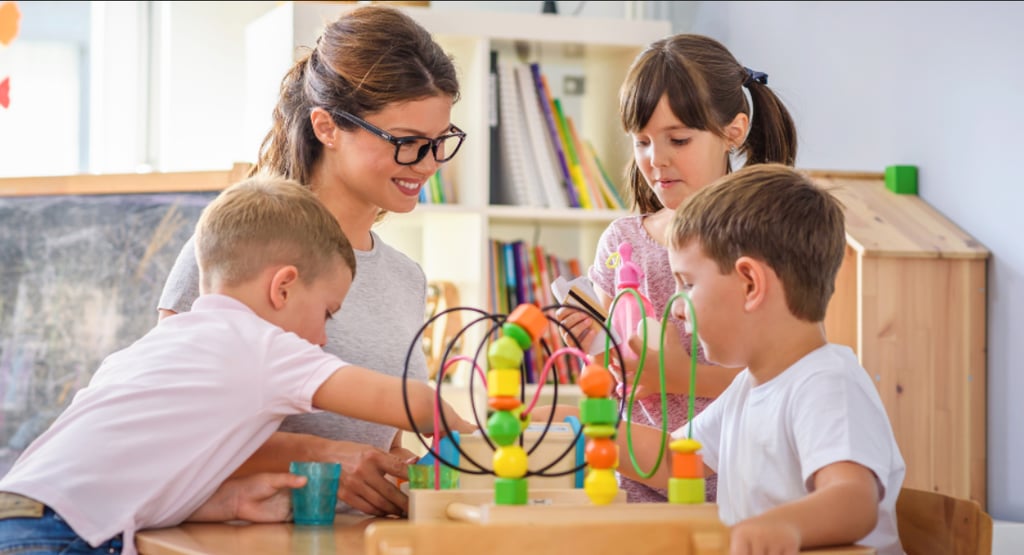Gender-Sensitive Classrooms in ECCE | Breaking Early Childhood Stereotypes
Explore how gender-sensitive classrooms in ECCE can break harmful stereotypes early on. Learn practical strategies for inclusive teaching in early childhood education.
ECCE
LevelUp Online Education
5/27/20254 min read


Introduction: Why Gender Sensitivity Starts in Early Childhood
Ever noticed how little girls are often praised for being "sweet" and boys for being "strong"? These subtle labels start building rigid gender roles from a very young age. That’s why creating gender-sensitive classrooms in ECCE (Early Childhood Care and Education) is not just ideal—it's essential. In those first formative years, young minds are like soft clay—what we model and say deeply shapes their worldview.
Let’s explore how to break stereotypes and build classrooms where every child, regardless of gender, feels equally seen, heard, and empowered.
What Are Gender Stereotypes?
Gender stereotypes are fixed ideas about how boys and girls "should" behave. For instance:
Boys are good at math and sports
Girls are better at art and emotions
Boys don’t cry
Girls shouldn’t be loud
These generalizations often limit children’s potential and make them feel boxed into certain behaviors.
Understanding the Impact of Gender Stereotypes in ECCE
1. Shaping Self-Image and Confidence
When boys are always encouraged to lead and girls are always asked to “help,” it can affect how they view their roles in the world. A girl might hesitate to take the lead in a group activity. A boy might feel shame for showing vulnerability.
2. Influencing Learning and Interests
Children may avoid certain toys or subjects because they fear it's "not for their gender." This limits cognitive, social, and emotional development. For example, if a girl avoids building blocks because it's seen as a “boy’s toy,” she may miss early STEM exposure.
3. Reinforcing Social Inequality
Classrooms that reflect gender bias—even unintentionally—can reinforce broader societal inequalities. These patterns, if left unchecked, grow with the child.
What Is a Gender-Sensitive Classroom in ECCE?
A gender-sensitive classroom in ECCE is one that actively identifies and challenges gender biases, offering equal opportunities to all children. It involves:
Using gender-neutral language
Providing diverse learning materials
Encouraging all children to express emotions
Offering equal access to activities
It’s about ensuring that every child can grow without being limited by society’s outdated notions of gender.
How Teachers Can Break Gender Stereotypes in ECCE
1. Use Gender-Neutral Language
Instead of “boys and girls,” try using “friends” or “children.”
Why this matters: It subtly shifts the focus from gender identity to group inclusivity and builds community.
2. Diversify Classroom Materials
Include books, posters, and toys that show boys as caregivers and girls as scientists, engineers, or adventurers.
Why this matters: It helps children visualize that anyone can be anything, regardless of gender.
3. Encourage All Forms of Play
Don’t label the doll corner as “for girls” and the block area as “for boys.” Let everyone play everywhere.
Why this matters: This expands their imagination and fosters a more holistic skill set, emotionally and intellectually.
4. Model Inclusive Behavior
Children learn by watching. Teachers should question their own biases and model respectful, open-minded interactions.
Why this matters: Young children internalize teacher behavior, making it a powerful tool for long-term change.
Creating Inclusive Learning Environments
1. Classroom Setup
Ensure the layout doesn’t reinforce division. Mix toys, create zones for collaboration, and avoid gender-coded colors (like pink vs. blue).
Why this matters: An environment that feels inclusive supports emotional safety and curiosity in all learners.
2. Equitable Participation
Rotate roles and responsibilities. Let boys help clean up, and girls lead games.
Why this matters: This teaches mutual respect and breaks the notion that certain roles are “just for boys” or “just for girls.”
3. Curriculum Choices
Use stories that include non-traditional families, career choices, and gender expressions.
Why this matters: Exposure to diversity builds empathy and normalizes difference as part of the human experience.
The Role of Families in Supporting Gender Sensitivity
1. Encourage Exploration at Home
Let children choose their toys, clothes, and interests without judgment.
Why this matters: It affirms their autonomy and helps them develop confidence in their choices.
2. Challenge Stereotypical Comments
If someone says, “Boys don’t cry,” correct it with, “It’s okay for everyone to show feelings.”
Why this matters: Kids absorb everything—calling out stereotypes helps unlearn harmful beliefs.
3. Engage in Gender-Sensitive Conversations
Talk to your child about respect, fairness, and how people are different—and that’s okay.
Why this matters: These conversations build emotional intelligence and critical thinking.
Benefits of Gender-Sensitive Classrooms in ECCE
1. Promotes Equality from the Start
Children learn that they are equals, regardless of their gender, fostering respectful peer relationships.
2. Builds Self-Esteem and Confidence
Kids are free to express themselves authentically, leading to stronger self-worth and social-emotional development.
3. Encourages Diverse Interests and Skills
Children are more likely to pursue a wide range of activities and develop varied skill sets, from empathy to problem-solving.
4. Reduces Bullying and Bias
A culture of acceptance discourages rigid thinking and nurtures kindness, curiosity, and community.
Training ECCE Educators in Gender Sensitivity
1. Professional development workshops: Equip teachers with tools to recognize and address gender bias.
2. Ongoing support and reflection groups: Encourage sharing of challenges and strategies.
3. Inclusive policy-making: Build a school-wide commitment to gender equity.
Why this matters: Well-informed educators become powerful agents of change in shaping a more equitable future.
Conclusion: Let’s Break the Stereotypes, One Classroom at a Time
It’s time we move beyond pink-and-blue thinking. A gender-sensitive classroom in ECCE isn’t just progressive—it’s essential for building a more compassionate, inclusive, and equal society. When children grow up in classrooms that respect who they are, they grow into adults who respect others for who they are.
Northern Hills Supremus, A-306, opp. Northern Heights, Dahisar East, Mumbai, Maharashtra 400068
LevelUp
admissions@leveluponline.in
© 2025. All rights reserved


levelup_online_education




LevelUp Online Education









